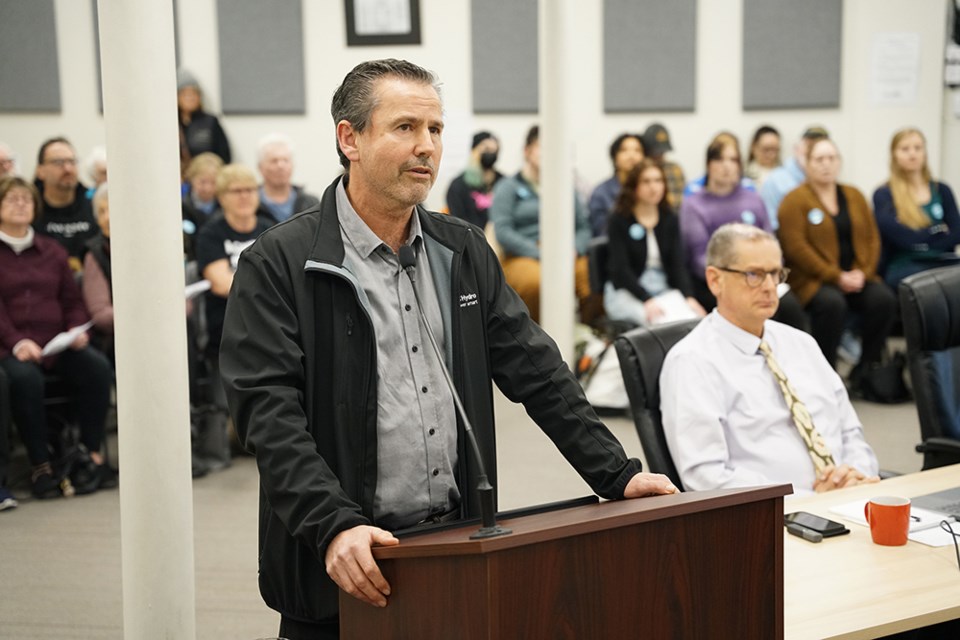BC Hydro will be replacing the high-voltage power lines over Jervis Inlet and Agamemnon Channel.
Stephen Watson, senior stakeholder engagement advisor with BC Hydro, appeared as a delegation at the City of Powell River committee of the whole meeting on February 18, outlining the project, which will affect ferry and marine traffic during the construction phase.
Watson said it is a challenging project in terms of the power lines that come across the two bodies of water.
He said there are two transmission lines, with one 138-kilovolt line that was put into service in 1956, and the 230-kilovolt line, which went into service in 1970. He said these go to the Saltery Bay substation.
“When the lines were put in place across Jervis Inlet, a 3.5-kilometre span, it was one of the largest power line spans over a marine environment in North America at the time,” said Watson. “There is also a 2.1 marine crossing over Agamemnon Channel.
“At Jervis Inlet, the towers on the side of the hill are located about 2.5 kilometres from Saltery Bay, going across to Nelson Island, and at Agamemnon Channel they are about 1.5 kilometres southwest of Earls Cove.”
Watson said BC Hydro is always looking at its facilities and reviewed these two transmission lines crossing over the marine areas. He said the electric utility found that both were at end of life in terms of the power lines and marker balls for aircraft. He said the deterioration is due to age and ocean spray and corrosion.
“We found the power lines and aviation balls for the 138 kV line were at high risk of failure,” said Watson. “We initiated an emergency-driven project last spring to replace those lines as soon as possible. We have been working on design and will be removing the lines and replacing them with new lines, along with some land-based work.
“The project is about ensuring public safety underneath the power lines along the main crossings, as well as maintaining electricity reliability.”
Watson said plans are to replace the 230 kV lines along the main crossings in a few years’ time. He said BC Hydro had been undertaking tree removal and working on access roads, and that will continue in 2025. He added that power line tower work will be done at the marine crossings as well.
“We’ll be removing the 138 kV lines and aviation marker balls sometime between mid-September and October of this year,” said Watson. “We will restring the lines the following year, in 2026. While we do that work, the 230 kV line will continue to provide power to the Powell River region.”
At Agamemnon Channel, the new lines will be installed in spring of 2026, with the 230 kV line providing power to that region.
Watson said when BC Hydro does the power line removal and restringing work, there cannot be any marine traffic below it.
“The marine area will be closed while we do that work,” said Watson. “There will always be one channel or inlet open, so when Jervis Inlet is closed, Agamemnon Channel will be open, and vice-versa.
“Jervis Inlet is obviously the BC Ferries route. I have been working with them since spring of last year regarding the project, trying to refine the schedule and activities. For BC Ferries, we want to make sure the communities remain connected for this essential service. We’re working on developing an alternate service, which includes an alternate schedule and alternate route options, which includes going around Nelson Island during the Jervis Inlet closure.”
Watson said once BC Hydro solidifies its schedule, BC Ferries will post its revised schedules. He said the first marine closures in Jervis Inlet will be between mid-September and October 31 this year for about six to nine days, 10 hours per day, to be confirmed by April. The second marine closure to string the new line will be in the fall of 2026, up to nine days, 10 hours per day.
Watson said BC Hydro has also been working with the Sunshine Coast Trail board of directors, because parts of the trail go through the BC Hydro project area. He said there have been some closures of the trail already and BC Hydro will be working with the trail board for future upgrades along the trail.
There will also be power disruption to the qathet region.
“We do require a planned outage to the community,” said Watson. “The timing for that is Sunday, September 14, from 7 am to 7 pm. This is strictly a power supply issue. We need to take the lines out of service, do the maintenance work and do the tie-in of the bypass route. There will be no impact to the marine area.”
Join the Peak's email list for the top headlines right in your inbox Monday to Friday.



